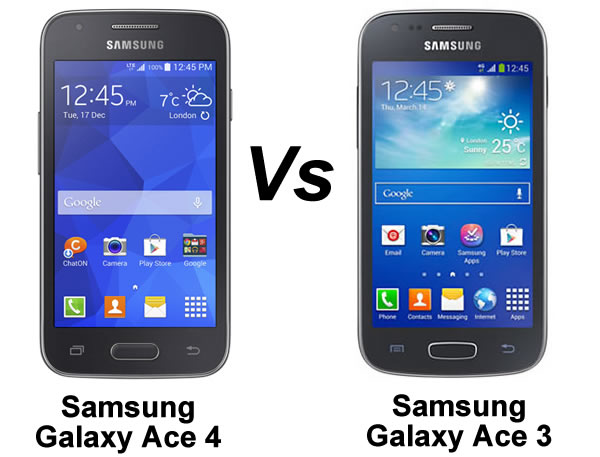
Samsung’s Galaxy Ace range is a popular lower mid-range line of smartphones and the latest in that line, the Galaxy Ace 4, has just arrived. In a sense it’s not one phone but two, as the 4G version has more differences than just data speeds.
So how do these new handsets compare to the older Galaxy Ace 3? And are they enough of an upgrade? Read on to find out.
Samsung Galaxy Ace 4 vs Samsung Galaxy Ace 3 – Build
When it comes to design and build there’s little to choose between these handsets. They’re all clad in plastic, with a plain back, large bezels, a faux-metal rim and home, back and multi task buttons below the screen. The only real difference is that the Galaxy Ace 3 has a slightly more rounded design, though the weight and dimensions vary as well.
The 3G version of the Galaxy Ace 3 comes in at 121.2 x 62.7 x 9.8mm and 115g, while the 4G version comes in at a marginally thicker and heavier 121.2 x 62.7 x 10mm and 119.5g. It’s a similar story with the Galaxy Ace 4, with the 3G version measuring 121.4 x 62.9 x 10.8mm and weighing 123.8g, while the 4G version is 121.4 x 62.9 x 11mm and 130.3g.
It’s also worth noting that both versions of the Galaxy Ace 4 are bigger and heavier than either version of the Galaxy Ace 3, though not enough that you’re likely to really notice. Ultimately then there’s very little to choose between their builds, but none of them come across as premium devices.
Samsung Galaxy Ace 4 vs Samsung Galaxy Ace 3 - Display
There’s no difference whatsoever between the screens on these devices. Both version of the Samsung Galaxy Ace 3 have a 4.0 inch 480 x 800 TFT display with a pixel density of 233 pixels per inch and so do both versions of the Galaxy Ace 4. They don’t have the crispest screens around and nor do they use the bright and vivid Super AMOLED displays that many Samsung phones are known for, but they’re reasonable quality all the same.
Power and performance

The 3G version of the Galaxy Ace 3 comes with a 1.0GHz dual-core processor, while the 4G version comes with a 1.2GHz dual-core processor, so it should be a little faster, however both handsets come with 1GB of RAM.
The Galaxy Ace 4 has a similar dual-core processor, with the 3G version clocked at 1.0GHz and the 4G version a slightly faster 1.2GHz, however here the 3G version only has 512MB of RAM, while the 4G version has 1GB.
Those are some fairly disappointing specs from the Galaxy Ace 4, as on paper that leaves it no more powerful than the Samsung Galaxy Ace 3 and in fact the 3G version is likely to be even less powerful as it has so little RAM.
They’re all a little lacking here really though, especially when super cheap phones like the EE Kestrel manage to include quad-core processors.
Camera
The camera is another area where there’s essentially nothing to choose between the various Ace’s. They all have a 5 megapixel main snapper with an LED flash and they all have a VGA front-facing camera, as well as being able to shoot 720p video at 30fps. All of which is about what we’d expect from a lower mid-range handset.
Battery life, memory and connectivity
The 3G versions of both the Samsung Galaxy Ace 3 and Samsung Galaxy Ace 4 have 1500 mAh batteries, while the 4G versions of each have 1800 mAh juice packs, however as 4G tends to use more battery than 3G and as the 4G handsets have faster processors that’s unlikely to translate to superior battery life.
The differences in memory will be more noticeable, as the 3G version of the Galaxy Ace 3 has just 4GB built in while the 4G version has 8GB. Strangely both versions of the Ace 4 are capped at 4GB, but all of these handsets also have a microSD card slot with support for cards of up to 64GB, so invest in a card and memory is unlikely to run short.
Nevertheless that all means that the 4G version of the Galaxy Ace 3 has more internal storage than either version of the Galaxy Ace 4, which seems odd.
The Galaxy Ace 3 seems strangely superior when it comes to connectivity options too. All four handsets support Wi-Fi, 3G and Bluetooth 4.0, while the 4G versions also support 4G LTE of course, but only the 4G version of the Galaxy Ace 3 supports NFC.
Samsung Galaxy Ace 4 vs Samsung Galaxy Ace 3 – Conclusion
The Samsung Galaxy Ace 4 is a handset that seems to be bordering on pointless. The 4G version seems to essentially be the same as the 4G version of the Galaxy Ace 3, just with a chunkier build, less storage and no NFC support, while the 3G version seems to be worse than either version of the Galaxy Ace 3 as it’s lumbered with just 512MB of RAM.
Seemingly the only real upgrade found in the Galaxy Ace 4 is that it runs Android 4.4, while the Galaxy Ace 3 is still on Android 4.2. In short then there’s no reason to upgrade from the Ace 3 to the Ace 4 and unless it’s priced at the same level as the Ace 3 then there’s no reason to choose it over the older handset either.
Samsung hasn’t yet confirmed the UK pricing of the Ace 4, but Samsung Netherlands lists it at 219 Euros, which is around £175, making it roughly £35 more expensive than the £140 that the Ace 3 starts at, so we’re not entirely sure that the Ace range will continue to be successful with this new model.







